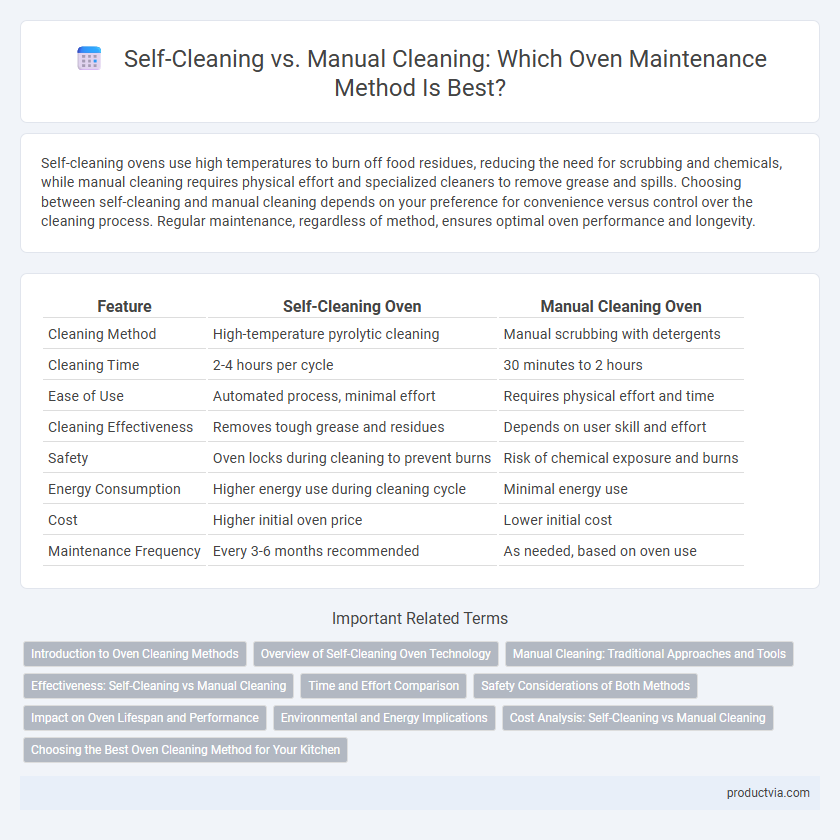Self-cleaning ovens use high temperatures to burn off food residues, reducing the need for scrubbing and chemicals, while manual cleaning requires physical effort and specialized cleaners to remove grease and spills. Choosing between self-cleaning and manual cleaning depends on your preference for convenience versus control over the cleaning process. Regular maintenance, regardless of method, ensures optimal oven performance and longevity.
Table of Comparison
| Feature | Self-Cleaning Oven | Manual Cleaning Oven |
|---|---|---|
| Cleaning Method | High-temperature pyrolytic cleaning | Manual scrubbing with detergents |
| Cleaning Time | 2-4 hours per cycle | 30 minutes to 2 hours |
| Ease of Use | Automated process, minimal effort | Requires physical effort and time |
| Cleaning Effectiveness | Removes tough grease and residues | Depends on user skill and effort |
| Safety | Oven locks during cleaning to prevent burns | Risk of chemical exposure and burns |
| Energy Consumption | Higher energy use during cleaning cycle | Minimal energy use |
| Cost | Higher initial oven price | Lower initial cost |
| Maintenance Frequency | Every 3-6 months recommended | As needed, based on oven use |
Introduction to Oven Cleaning Methods
Oven cleaning methods include self-cleaning and manual cleaning, each offering distinct benefits for maintenance. Self-cleaning ovens use high temperatures to incinerate residues, reducing effort and chemical use. Manual cleaning requires scrubbing with detergents and abrasives, allowing targeted removal of stubborn stains and grease buildup.
Overview of Self-Cleaning Oven Technology
Self-cleaning ovens utilize high-temperature pyrolytic cleaning cycles that incinerate food residues and grease, reducing them to ash for easy removal. This technology eliminates the need for harsh chemical cleaners and manual scrubbing, offering a more convenient and environmentally friendly maintenance option. Modern self-cleaning ovens often feature safety locks and programmable settings to optimize cleaning efficiency and protect users during operation.
Manual Cleaning: Traditional Approaches and Tools
Manual cleaning of ovens involves using traditional tools such as scrapers, sponges, and non-abrasive cleaning agents to remove baked-on grease and food residues. This method requires regular maintenance to prevent heavy buildup and often includes applying baking soda or vinegar solutions for effective degreasing. Despite being labor-intensive, manual cleaning allows for targeted attention to stubborn stains and avoids the high temperatures of self-cleaning cycles that may damage oven components.
Effectiveness: Self-Cleaning vs Manual Cleaning
Self-cleaning ovens use high temperatures around 900degF to incinerate food residues, effectively turning them into ash that can be easily wiped away, making this method highly efficient for built-up grime. Manual cleaning requires scrubbing with specialized oven cleaners or natural solutions, which can be labor-intensive but allows for targeted removal of stubborn stains and grease that high heat might miss. While self-cleaning offers convenience and thorough sanitization, manual cleaning provides precision and avoids potential risks associated with extreme oven temperatures.
Time and Effort Comparison
Self-cleaning ovens use high temperatures to burn off food residues, significantly reducing the time and physical effort required compared to manual cleaning. Manual cleaning demands scrubbing with chemicals and can take several hours, depending on the oven's condition. Choosing a self-cleaning feature optimizes maintenance efficiency by minimizing user intervention and cleaning duration.
Safety Considerations of Both Methods
Self-cleaning ovens use high temperatures around 900degF to incinerate food residue, reducing chemical exposure but posing burn risks and the release of smoke or fumes, necessitating ventilation and caution during the cycle. Manual cleaning involves using chemical cleaners or scrubbing, which may expose users to harsh substances and potential skin or respiratory irritation, requiring protective gloves and masks. Both methods demand careful handling, but self-cleaning ovens must be monitored to prevent fire hazards, while manual cleaning emphasizes the safe use of cleaning agents.
Impact on Oven Lifespan and Performance
Self-cleaning ovens use high temperatures to burn off residue, reducing manual scrubbing and helping maintain consistent heating elements, which can extend the oven's lifespan by preventing buildup-related damage. Manual cleaning requires regular attention to prevent grease and food debris accumulation, which can cause uneven heating and potentially shorten the oven's operational life. Proper maintenance through either method ensures optimal oven performance, but self-cleaning functions offer a more thorough cleaning process that minimizes wear on interior components.
Environmental and Energy Implications
Self-cleaning ovens use high heat to burn off food residues, reducing the need for chemical cleaners but consuming significant energy during the cleaning cycle. Manual cleaning requires environmentally harmful solvents or sprays, leading to potential indoor air pollution and chemical waste disposal concerns. Choosing between self-cleaning and manual methods depends on balancing energy consumption with the environmental impact of cleaning agents.
Cost Analysis: Self-Cleaning vs Manual Cleaning
Self-cleaning ovens use high temperatures to burn off food residues, reducing manual labor but consuming significant electricity, which may increase utility bills by 15-25%. Manual cleaning requires less energy but involves purchasing chemical cleaners and spending 30-60 minutes per session, leading to indirect costs in time and potentially harsher cleaning agents. Over the lifespan of an oven, self-cleaning models can lead to higher upfront costs but lower ongoing labor expenses, whereas manual cleaning remains cost-effective for lower electricity consumption but demands more frequent intervention.
Choosing the Best Oven Cleaning Method for Your Kitchen
Self-cleaning ovens use high temperatures around 900degF to incinerate food residues into ash, reducing manual scrubbing effort and saving time. Manual cleaning requires specialized oven cleaners and scrubbing tools to effectively remove grease and baked-on spills, providing more control over the cleaning process and preventing potential heat damage. Choosing the best oven cleaning method depends on factors like oven type, frequency of use, cleaning convenience, and sensitivity to harsh chemicals or heat exposure.
Self-cleaning vs Manual Cleaning for Oven Maintenance Infographic

 productvia.com
productvia.com